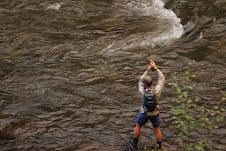 quirming around the bottom of the fish tank. Some have swam out of the basket that holds the eggs in the tank. Many are still mixed in with the remaining eggs that haven't hatched yet. The early hatching of the eggs came as a little bit of a surprise. We were anticipating the eggs hatching around the middle of December. Apparently, the hatchery in Anchorage sends out eggs that have been fertilized a slightly different times and have been developing longer than others. Therefore, we witnessed eggs hatching right around 400 ATUs, which is normal for Coho salmon. I am expecting that we will still have some eggs that haven't hatched by the middle of December, but most of them should be hatched. Keeping my fingers crossed.
quirming around the bottom of the fish tank. Some have swam out of the basket that holds the eggs in the tank. Many are still mixed in with the remaining eggs that haven't hatched yet. The early hatching of the eggs came as a little bit of a surprise. We were anticipating the eggs hatching around the middle of December. Apparently, the hatchery in Anchorage sends out eggs that have been fertilized a slightly different times and have been developing longer than others. Therefore, we witnessed eggs hatching right around 400 ATUs, which is normal for Coho salmon. I am expecting that we will still have some eggs that haven't hatched by the middle of December, but most of them should be hatched. Keeping my fingers crossed.
The students have been very willing to help maintain the water quality of the tank and to help remove eggs that died before hatching as well as some alevin that didn't fully emerge from the eggs and thus died. When the alevin start hatching, the embryonic fluid inside the eggs starts to build up and create a foamy layer on the top of the water. This is a critical period of time for maintenance and doing water changes to minimize the amount of foam in the water. These embryos require very high water quality and will die if toxins build up and don't get cleared out. In the natural environment, this embryonic fluid flows on downstream and allows the alevin to develop in the fresh water.

Thankfully, the alevin do not need much maintenance after they have hatched. The carry a giant yolk sac, like some grotesque, over-extended stomach. This is their food supply for the next 4 weeks. So when I return from Christmas break in early January, I will most likely find that some of the alevin have "buttoned up", meaning they have used up their yolk sac and will be looking to start feeding in the water column. During this time, the salmon fry will shoot to the surface and take in gulps of air to help inflate their swim bladder, which will enable them to maintain their buoyancy level in the water column. The tank will take on a whole new look. Then again, since this is my first experience in raising salmon in the classroom, I'm not really sure what to expect when I get back to my classroom. We'll have to wait and see.
Stayed tuned!







No comments:
Post a Comment